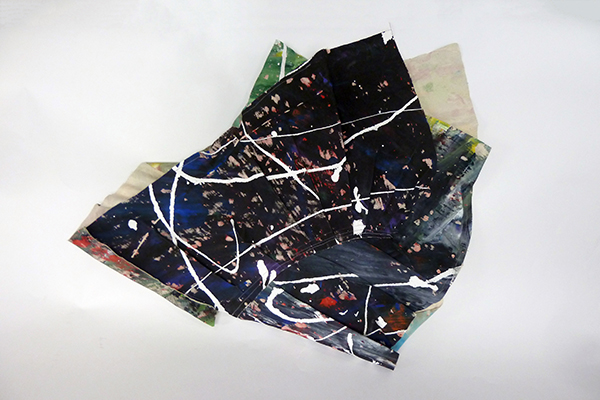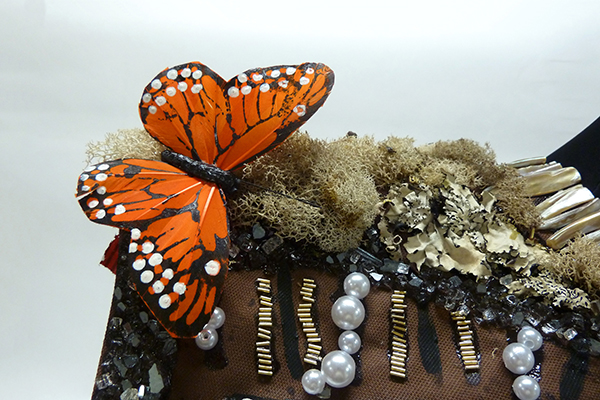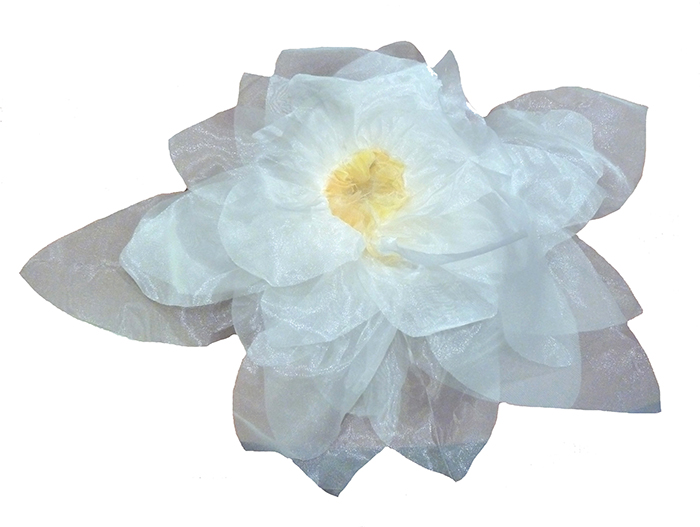FLORA AND FASHION: TAM 4480 Student Designs
TAM 4480 Creativity and Problem Solving ART(WEAR) OFF THE WALL DESIGN PROJECT
For this project, Textile and Apparel Management students in TAM 4480 Creativity and Problem Solving were asked to create a textile art piece intended to hang on a wall, but that can also be worn. This year their beginning inspiration and story was the Missouri Historic Costume and Textile Collection’s fall exhibit, Flora and Fashion, with freedom to choose the focus of their creative research. Surface design was critical to create the visual 2D interest as wall art, but the ability to interact with the 3D body was also important. Texture and dimensionality could also be used as part of the 2D work. Continue below to view student designs. Return to the Flora and Fashion Exhibition.
STUDENT DESIGNS
(Alphabetical by Last Name):
Megan Alexander; Hope Beykirch; Stephanie Graviett; Mary Hershberger; Amanda Lee; Adriana Martin; Natalie Oplt; Alli Phaup; Maddie Sinn; Molly Wainscott; Jenny Wu; Chance Zacheis; Tingting Zhu
FRAGILE STRINGS
By Jenny Wu (2019)
The inspiration for my design is leaf vines. They are visible vines in a beautiful net structure on the leaf. They provide nutrition to ensure the smooth progress of leaf functions. Another inspiration was a skeleton leaf bookmark art project I did in China’s primary school. We used chemicals to boil leaves to remove the mesophyll from vines, dyed them, and turned them into beautiful bookmarks.
My final class project is a shell with a soft beige color. The whole design is the combination of this beautiful and detailed leaf vine structure with the sheerness of skeleton leaf to create wearable art. I chose organza as a ground to hand-paint the vines and added some actual leaf skeletons for added texture and to make it look more three-dimensional. The sheerness of organza is perfect for showing the transparency of the skeleton leaf, and the shape of my design is like an abstract version of twisted skeleton leaves. The meaning of this design is presenting people with the essence of leaves and how strong they are. People might think leaves are fragile, however, after boiling with chemicals and removing the mesophyll, the vines are staying together and keep their shape. Moreover, leaf vines are like quietly selfless dedicated people, doing things in their own way to give back to society and the world. This design is my way to pay tribute to them.




WEEPING WILLOW
By Adriana Martin (2019)
The theme of this project was plants. My inspiration was the willow tree. I chose the willow tree because of the significance it had in my childhood. Willow trees signify strength, stability, and the ability to bend without breaking. For me, I remember as a child playing around with my family’s willow tree. I loved the way the willow tree vines would hang over me and make me feel secure. The sense of security the willow tree gave me as a child lead me to create a piece that could wrap around the body. The vines of a willow tree are light which is what drew me to use yarn. The sturdiness of the tree trunk moved me to use burlap for the base. These materials were chosen because they are lightweight and won’t feel heavy on the body. The art piece can to go on the body by wrapping around and attaching at the shoulder, and will feel light and airy on the body. The strands of yarn move when walking, like the branches on willow trees in the wind.



HAVEN
By Chance Zacheis (2019)
Linen is an ancient fabric, even older than cotton, that is produced from the flax plant. In many different cultures and religions, linen is traditionally wrapped around the body when a person passes. The idea of wrapping the corpse in linen to shelter the physical body is significant because the spiritual component is that the fabric is also sheltering the soul as it makes its journey through the transitional circle of life. I chose to represent that point in time of passage by creating a Mobius strip – a circle that is ongoing with a twist that creates dimension. There is only one surface on the mobius strip but the structure of the illusion it presents, as well as the history behind the many traditional uses of flax, inspired me to create the story of Haven.
By dampening the linen, I was able to create interesting folds and gathers that I stiffened with a solution to hold the shape once it dried. Whilst on the body, the garment wraps around the wearer’s shoulders in a protective drape that is angelic in aesthetic. Hanging on the wall, one sees the flow and structure of the continues strip and its relations with the story of transition. The burst of color and withering at the base of the strip alludes to the universal experience that life is often not perfect and will continue to deteriorate, but the circle persists nonetheless.




FREE BIRD
By Amanda Lee (2019)
The art (wear) off the wall project, inspired by Flora and Fashion, is intended to create a piece of artwork that can be displayed on a wall but also displayed on the body. For this project, I was inspired by the bird of paradise, a gorgeous flower found in hot tropical regions such as Hawaii and South Africa. This flower contains many different meanings and is used on special occasions in various cultures. One meaning of the flower that sparked a lot of ideas, was the symbolism of the flower as joy and freedom. To incorporate the meaning of freedom I designed the art pieces to allow large amounts of exposed body. I also admire the bright colorful flowers of the petals, stems and leaves of the bird of paradise. I wanted to incorporate those bright colors into the artwork as well, to represent the flower but also for the bright colors to promote joy. The entire artwork is made of 100% cotton. This is for two reasons; I wanted to use a fabric that closely correlate to the theme of plants and flora and also because cotton takes well to dyes. For the structure of the art I used a decorative interfacing to provide stiffness to the petals and leaf.



EVERLASTING OASIS
By Alli Phaup (2019)
Everlasting Oasis focuses on how beautiful and resilient the environment can be. Specifically, this piece is inspired by succulents because they symbolize unconditional love and tenacity. They are hardy and adaptable which allows them to thrive in harsh conditions. They are one of the most durable plants because their thick and fleshy surface allows them to retain water for long periods of time. They also have a hairy, waxy, or spiny outer layer to help shield the plant and protect it from the sun and reduce water loss. I want my piece to look like a succulent when it is hanging on the wall, but when it is worn on the body it is unfolded and spikes protrude from the sides, keeping people at a distance. Part of the materials I used are made from plant products, such as cotton.
The purpose of this piece is to show how strong plants can be and the amazing things they can do for our environment. People treat the environment so terribly, but it’s difficult to hurt a succulent because they are so sturdy. Succulents also symbolize the ability to achieve greatness even in the worst times. No mater how bad the environment gets with recent natural disasters and humanities poor treatment, succulents represent the environment’s greatness because they are still alive and thriving.



TITAN
By Natalie Oplt (2019)
The Amorphophallus titanum, or titan arum, more commonly known as the corpse flower, is a large flowering plant that can reach up to 10 feet tall with a growth cycle of seven to ten years. The flower’s bloom only lasts for up to 48 hours, and while in bloom, the plant releases an odor similar to rotting fish. My design was inspired not only by the bright colors of the corpse flower, but also the juxtaposition of fragility and determination showcased in the plant’s lifecycle. The fabric is made from silk and hemp and was dyed using spinach and blackberries. Fusible foam was used to create the large flower, and hand-pleating was used to create the stem of the plant.



CHAOS
By Molly Wainscott (2019)
Chaos represents how unnatural man’s version of nature is within the modern world. The front encompasses what is believed to be the definition of nature, emphasizing colors found within plants, flowers, water, and trees. Everything appears to be harmonious, relaxing, and heavenly. However, in reality, we have our backs turned from nature’s true current state. Metaphorically, the back of Chaos portrays what is happening within our ecosystem. It is a dark reality that features wildfires, droughts, rising temperatures, extinctions, and extreme conditions. This feeling is evoked through the use of black, red, orange, and other darker colors representative of nature’s chaos.




BLOWN AWAY
By Stephanie Graviett (2019)
Dandelions, known as one of the most successful plants to exist, are very effective survivors. As they transform through the flowering process, the dandelion flower dies and then re-flowers with seeds. These seeds are fluffy, delicate and easily blown by a small gust of wind which helps distribute the seeds, resulting in a new flowering process. These seeds create movement and whimsy as well as take part in creating a new flower life cycle. My design process was focused around the movement of the dandelion seeds. The circle shape represents the flower, and the embroidery represents the flower texture. I used ostrich feathers to represent the fluffy seeds, and arranged them around the circle to mimic the blowing of the seeds and the new flower life about to form.



MOTHER NATURE: ORGANIZED CHAOS
By Hope Beykirch (2019)
When given the theme of Flora and Fashion, I immediately went to the bigger picture, Mother Nature. I wanted to convey an image of her as a warrior, one who can withstand so much destruction, some of it man-made. This is where I interpreted my structure; I wanted to create a sense of a protective covering, almost like battle armor. I wanted to show the organized chaos of nature. There are so many components that go into the ecosystem. I hand attached each bead with the intention of manifesting the awareness of individuality but how it all comes together to form a bigger picture.




(UN)ZIPPED*: EXPLORING AMERICA’S COMPLEX LEGACY WITH CANNABIS
By Mary Hershberger (2019)
* Zip (noun): (slang) an ounce of cannabis
While recent American attitudes towards cannabis have relaxed significantly since the anti-marijuana films and legislation of the 1930s, America’s legacy with cannabis has a far longer and more complex history. Before the passage of the Marijuana Tax Act of 1937—legislation which essentially criminalized and outlawed marijuana and greatly harmed the hemp industry—the plant had been part of American life since the country’s earliest days, where colonists on the East Coast farmed industrial hemp. Throughout the 20th century, marijuana became a taboo cultural fascination to Americans. Whether it’s Reefer Madness, Woodstock and the hippies, jazz musicians of the 40s, or the legalization movement into the 21st century, cannabis has continually influenced our culture.
For my project, I wanted to create a commentary on American cannabis culture that could explore the polarizing views that have floated in and out of the mainstream. I created a poncho that folds into a plastic bag of marijuana, and the writing—which is upside down when worn, but legible when hung on the wall—has two sides that use both positive and negative terms about marijuana. While one side will be in focus from the front, the other will be obscured but still visible, representing the sustained minority of the other argument throughout time.



RETURNING TO NATURE
By Tingting Zhu (2019)
The inspiration for my design was the water lily, a perennial aquatic herb born in ponds and lakes. The water lily likes a sunny, well-ventilated environment. The purifying effect of water lily on phosphorus and nitrogen is obvious. It can also absorb toxic substances such as lead, mercury and phenol in water. It is not only a rare plant for water purification, greening and beautification, but it also makes our city more fresh and natural.
Last summer, when I returned home to Hongcun, one of the most beautiful and ancient towns in Anhui Province, China, I came into contact with nature and saw the beauty of water lilies. The scenery is like a Chinese painting. The lake was clear, the arch bridge like a rainbow, and the surrounding mountains were reflected on the lake. It makes people feel in touch with nature, away from the noise of the city. Therefore, I took my experience and the characteristics of water lilies as examples to convey the importance of returning to nature. I chose white silk organza as my main fabric to show the purity of water lilies. I drew the edges of the fabric into silk to make it more like the pistils of a water lily. Yellow watercolor dyes were used to highlight the theme of nature and sunshine. I hope this work can make people feel purified and return to nature.



THE NATURE OF DECEPTION
By Maddie Sinn (2019)
My flora project explores the idea of deception. I was intrigued by the naturally occurring colors and textures of various flowers but my inspiration came from the purpose behind their beauty. The soft petals and bright colors actually serve a purpose: to attract, or reproduce. Humans act in the same manner, making themselves more attractive by dieting, dyeing their hair or buying new clothes. But these external modifications are not always indicative of what is truly inside. So, to portray this deception, I created beautiful, bright flowers to mimic poisonous flowers found in nature. By displaying them in a harmonious way, I attempted to distract the viewer by making him or her only think about the flowers’ beauty and forget the possibility of danger.


MYSTERIOUS BLOOM
By Meghan Alexander (2019)
My inspiration came from the crinum amabile, or spider lily, that blooms in early September, right after a rain storm. Spider lilies are often referred to as the magic flower. As there is no sign indicating where their bulbs are planted, when the flower blooms, it appears as a surprise, or like magic. What was once a dull-colored field turns into a vibrant blanket of colorful spider lilies. I took inspiration from the vibrant colors of spider lilies and the shapes of the petals. This piece represents a breath of fresh air with its vibrant colors and shape in a dull environment.

